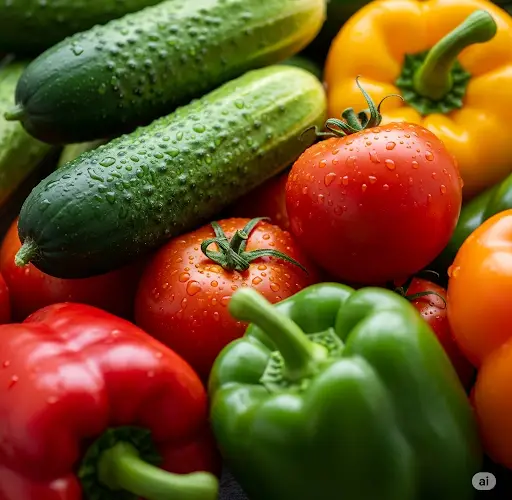The height of summer is a crucial time for gardeners. As July rolls into August, warm temperatures and long days give fruiting vegetables like cucumbers, tomatoes, and peppers the perfect conditions to thrive—if they receive the right care. But even healthy plants can experience a sudden slowdown in fruit production if their nutritional needs aren’t met.
If your cucumbers, tomatoes, or peppers seem to be struggling to produce—or if you simply want to maximize your harvest through August—this article reveals a time-tested, natural feeding method that dramatically boosts fruiting. With one simple application, you can turn your vegetable beds into lush, fruit-loaded producers, giving you crisp cucumbers, juicy tomatoes, and vibrant peppers in abundance.
Why Mid-Season Feeding is Critical
Many gardeners focus heavily on spring soil prep and early growth but underestimate how much energy plants expend once they begin to flower and fruit. By midsummer, cucumbers, tomatoes, and peppers are in full production mode, drawing heavily on soil nutrients to fuel ongoing blooms and ripening fruit.
Without timely replenishment, plants may:
-
Slow or stop flowering
-
Produce fewer or smaller fruits
-
Drop flowers prematurely
-
Show signs of nutrient stress, such as pale leaves or poor growth
This is why a mid-season nutrient boost can make the difference between a disappointing harvest and a prolific one.
The Ultimate Natural Feeding Solution
This mid-summer feeding method provides a powerful blend of macro and micronutrients that nourish the plant, enhance flowering, and boost fruit set. It supports plant metabolism, improves resistance to stress, and maintains high yields even in hot weather.
Here’s what you need to prepare the booster:
Ingredients:
-
1 tablespoon of wood ash (rich in potassium and trace minerals)
-
1 tablespoon of composted chicken or cow manure or a handful of well-rotted compost (provides balanced nutrients)
-
1 teaspoon of baking soda (helps prevent fungal issues and keeps roots healthy)
-
1 tablespoon of sugar or molasses (feeds beneficial microbes in the soil)
-
2 liters of warm water
Preparation Steps:
-
In a large container, mix all the ingredients together thoroughly.
-
Stir the mixture until the sugar/molasses and other elements are fully dissolved.
-
Let the solution sit for 30 minutes to activate the microbial components in the compost.
-
Strain if using a watering can with a narrow spout or apply directly to the soil.
How to Apply:
-
Timing: Apply this feeding early in the morning or late in the afternoon to avoid scorching the plants during midday heat.
-
Dosage: Use 300–500 ml per plant depending on its size.
-
Method: Pour directly at the base of each plant, avoiding the leaves to reduce fungal risk.
-
Frequency: Apply every 10–14 days during peak fruiting season.
Why This Works So Effectively
-
Wood ash delivers potassium, which is essential for flowering and fruit development. It also adds calcium and magnesium, which support cell structure and prevent blossom-end rot in tomatoes and peppers.
-
Composted manure provides slow-release nitrogen and phosphorous—critical for maintaining strong stems and continued flowering.
-
Baking soda gently combats soil acidity and helps prevent fungal issues around the root zone.
-
Sugar or molasses supports microbial life in the soil, making nutrients more bioavailable and improving plant uptake.
This combination not only feeds your vegetables but also improves the soil health, ensuring sustained productivity through the remaining summer weeks.
Signs the Feeding is Working
After just 7–10 days, you may notice:
-
Increased number of flowers and new fruit forming
-
Deeper green, stronger foliage
-
Fewer signs of stress from heat or dryness
-
Fuller, heavier fruit sets and more consistent ripening
By mid to late August, your plants will be producing vigorously, often giving you harvests every few days.
Extra Tips for Prolonged Fruiting
To further extend and improve your harvest:
-
Regularly harvest mature fruit to encourage continuous production.
-
Mulch around the base of plants to retain moisture and moderate soil temperature.
-
Water consistently, especially during dry spells, to avoid fruit splitting or blossom drop.
-
Remove yellowing leaves and prune suckers from tomato plants to improve airflow and reduce disease.
Conclusion: Feed Now for a Strong Finish
Don’t let the peak of summer pass you by with weak yields. An urgent mid-season feeding of cucumbers, tomatoes, and peppers with this simple natural solution can transform your garden. By boosting nutrient levels and improving soil vitality, your plants will reward you with baskets full of fresh, flavorful produce right through August and beyond.
Try this method today, and watch your harvest multiply. It’s not too late for an abundant summer crop!



